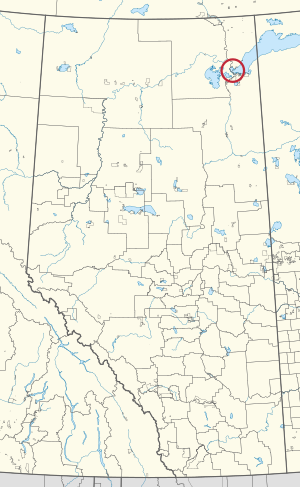Dog Head 218 facts for kids
Quick facts for kids
Dog Head 218
|
|
|---|---|
| Dog Head Indian Reserve No. 218 | |

Location in Alberta
|
|
| First Nation | Mikisew Cree |
| Treaty | 8 |
| Country | Canada |
| Province | Alberta |
| Specialized municipality | Wood Buffalo |
| Area | |
| • Total | 34.8 ha (86.0 acre) |
| Population
(2016)
|
|
| • Total | 99 |
Dog Head 218 is a special place in Alberta, Canada. It is an Indian reserve for the Mikisew Cree First Nation. This community is located within the Regional Municipality of Wood Buffalo. In 2016, 99 people lived here.
Contents
About Dog Head 218
Dog Head 218 is a small area of land. It is officially known as Dog Head Indian Reserve No. 218. This land is set aside for the Mikisew Cree First Nation. It helps them keep their culture and traditions alive.
Where is Dog Head 218?
This reserve is found in the province of Alberta, Canada. It is located within a larger area called the Regional Municipality of Wood Buffalo. The reserve covers about 34.8 hectares. That's about the size of 65 football fields!
Who Lives Here?
In 2016, 99 people called Dog Head 218 home. They lived in 39 private houses. This shows it is a small, close-knit community. The people living here are members of the Mikisew Cree First Nation.
What is an Indian Reserve?
An Indian reserve is land that the Canadian government has set aside. This land is for the use and benefit of First Nations people. These lands are protected. They help First Nations communities maintain their unique ways of life.
The Mikisew Cree First Nation
The Mikisew Cree First Nation is an Indigenous group. They are part of the larger Cree nation. The Cree people have lived in parts of Canada for thousands of years. The Mikisew Cree have a rich history and strong cultural traditions. They have a deep connection to their land.
Understanding Treaty 8
Dog Head 218 is part of Treaty 8. A treaty is like a big agreement between different groups of people. Treaty 8 was signed a long time ago, in 1899. It was an agreement between the Canadian government and several First Nations, including the Mikisew Cree. These treaties are very important. They define the rights and relationships between First Nations and the government.

